|
|
|
Sort Order |
|
|
|
Items / Page
|
|
|
|
|
|
|
| Srl | Item |
| 1 |
ID:
145529
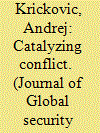

|
|
|
|
|
| Summary/Abstract |
Realists are accustomed to thinking about security competition between states in terms of the security dilemma: each state's efforts to improve its security can be taken as a threat by others, sparking competition that destabilizes the system and increases the likelihood of conflict. By focusing almost exclusively on external threat dynamics, however, common thinking about the security dilemma misses how domestic vulnerabilities can also be a catalyst for security competition. This is particularly the case in “weak” states that lack internal legitimacy. Weak developing states see intervention (whether perceived or real) targeted at their domestic vulnerabilities as an existential threat to political survival. When the targeted state responds to minimize or negate the threat, its response may be perceived as a threat, warranting a counter response. Particularly, when a targeted state possesses significant national power—as in the cases of China and Russia—a security competition is born. This article develops the logic behind this modified version of the security dilemma focused on internal vulnerabilities. Managing these internal fears will be of critical importance if we are to avoid the reemergence of security competition between great powers in the future.
|
|
|
|
|
|
|
|
|
|
|
|
|
|
|
|
| 2 |
ID:
145530
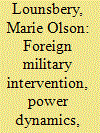

|
|
|
|
|
| Summary/Abstract |
Third-party states use foreign military intervention as a tool to influence the outcome of intrastate conflict. The literature identifies other consequences associated with this intervention but has not yet examined its effect on rebel group cohesion. We might expect rebel groups to coalesce or splinter depending on the direction of the intervention. This paper tests this relationship on all intrastate armed conflicts during the period from 1975 to 2009. It finds that rebels tend to coalesce when a foreign power intervenes on their behalf. External interventions, whether supporting the rebels or the government, however, do not appear to influence rebel group splintering.
|
|
|
|
|
|
|
|
|
|
|
|
|
|
|
|
| 3 |
ID:
145532
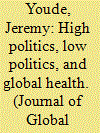

|
|
|
|
|
| Summary/Abstract |
It has become commonplace to argue that global health has ascended from “low politics” to the ranks of “high politics” in international relations—those issues of existential importance to the state and which concern its very survival. Despite its ubiquity, the actual substance of such a shift in the framing of global health is largely unexamined. In this article, I argue that empirical evidence belies the idea that global health is a “high politics” issue. This dichotomy makes little sense, and efforts to reframe global health as a “high politics” or securitized issue rarely succeed. While it is undoubtedly true that global health has received significantly greater attention from the international community over the past twenty-five to thirty years, that attention does not spring from global health being reframed as a “high politics” issue for states.
|
|
|
|
|
|
|
|
|
|
|
|
|
|
|
|
| 4 |
ID:
145531
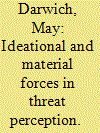

|
|
|
|
|
| Summary/Abstract |
How do states perceive threats? Why are material forces sometimes more prominent in shaping threat perceptions, whereas ideational forces are the motivator in other instances? This article aims to move beyond the task of determining whether material or ideational factors matter to offer an integrated framework based on analytical eclecticism that specifies the conditions under which one of these two factors becomes salient in regimes’ threat perceptions. When regime identity is fixed and the material structure provides multiple strategic options to ensure a state’s physical security, leaders perceive challenges to their identity as more salient. When a state's identity is fluid, providing multiple narratives, and the distribution of military capabilities constrains strategic options for physical security, leaders perceive threats to their physical security as more prominent. As a result, the regime’s identity narrative is reframed to adapt to the constraints of the material structure. To examine the validity of this argument, I analyze the divergent Syrian and Saudi threat perceptions during the Iran–Iraq War (1980–1988).
|
|
|
|
|
|
|
|
|
|
|
|
|
|
|
|
| 5 |
ID:
145533
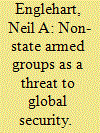

|
|
|
|
|
| Summary/Abstract |
What kind of security threats do non-state armed groups pose, and to whom? The literature has tended to take the state as a reference point for the study of non-state armed groups: insurgents have long been regarded as domestic military threats, and since 9/11, terrorism has been increasingly treated as a major transnational military threat. Because literature on armed non-state actors typically situates them in the context of war or protracted conflict, the state-centric and militarized view of these groups is rarely contested. However, data on 232 armed groups in twenty-three Asian countries from 1985 to 2014 show that the primary threat such groups most consistently pose is to the human security of local civilian populations, rather than the military security of states. A human security perspective suggests alternatives to military responses, the need for more tailored non-military interventions, and the necessity of improved data collection on non-state armed groups that exist in- and outside the context of conventional war.
|
|
|
|
|
|
|
|
|
|
|
|
|
|
|
|
|
|
|
|
|